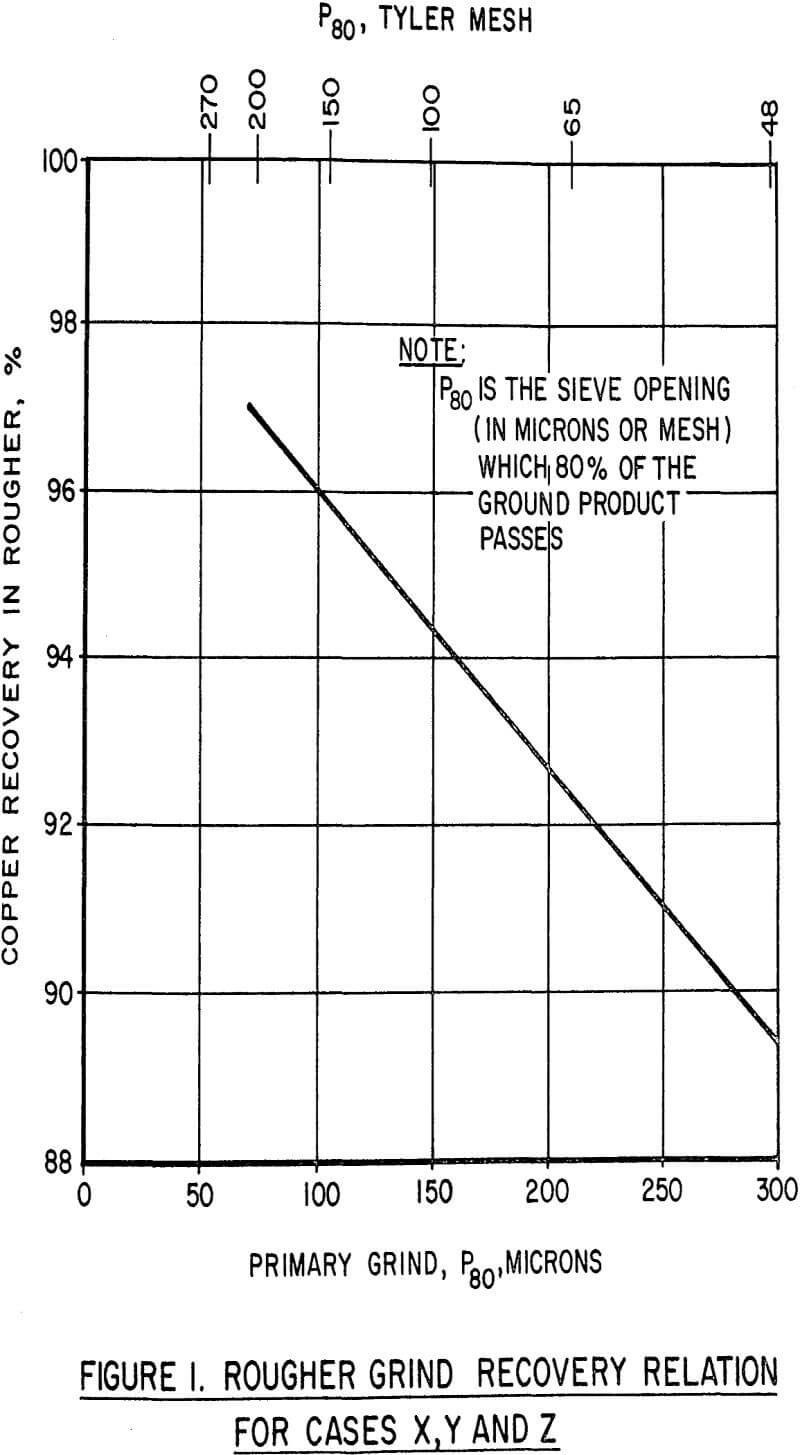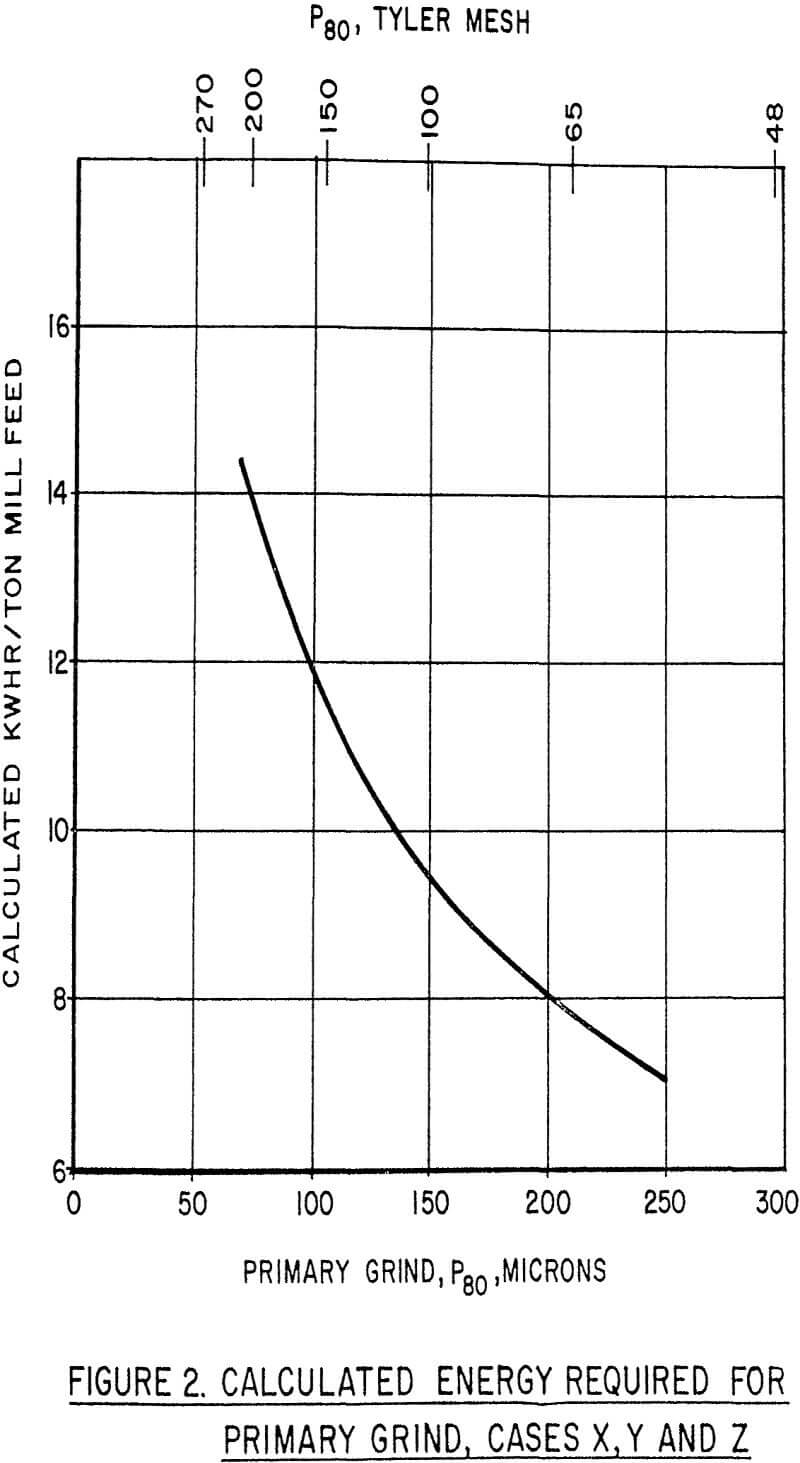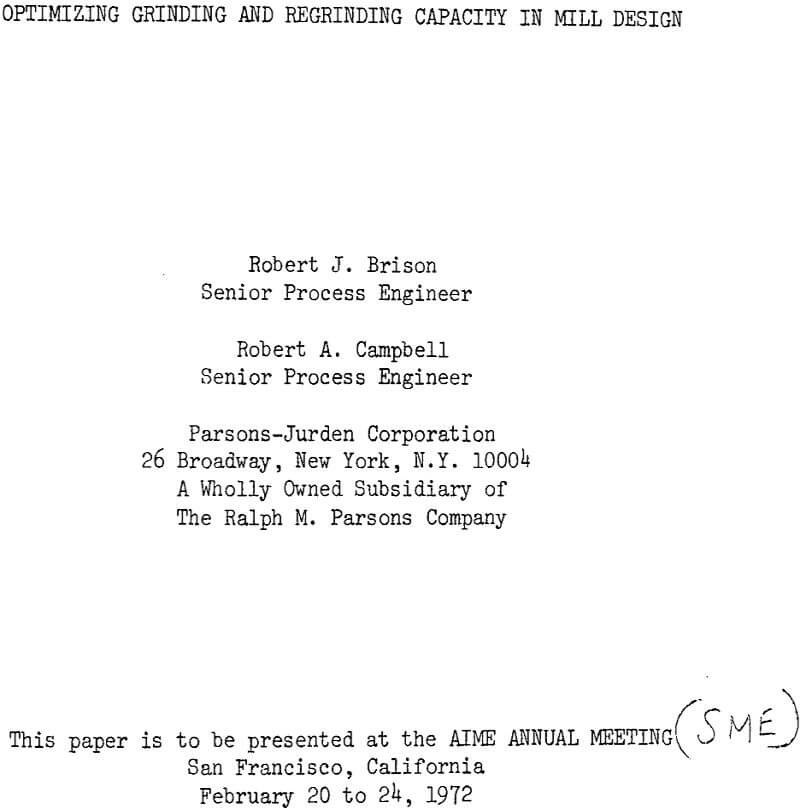Table of Contents
The intent of this paper is to try to answer the complex question: “How much grinding capacity should be designed into a new mining – milling project?” Much work has been devoted to the technical aspects of grinding, the “how” of grinding. But, in the writers’ opinion, the economically important subject of optimizing grinding capacity in mill design has not received the attention it deserves, at least not in published literature.
Optimizing Primary Grinding Capacity
The relation of fineness of grind to the degree of liberation of the valuable minerals from the gangue is certainly a factor to be considered in optimizing the primary grind. This largely determines the grind-recovery curve and the point of maximum recovery, which is normally at a very fine grind. However, it is obviously not the only factor to be considered. How closely the optimum grind actually approaches the maximum-recovery grind depends on the following factors:
- Grindability
- Operating Cost Factors
- Capital Cost Factors
- Product Value
- Mining Factors
In any plant, considerable fluctuation normally occurs in grade of ore, grindability and fineness of dissemination. However, since grinding is usually by far the most expensive unit operation in a concentrator, the grinding capacity is normally designed for average rather than extreme conditions, with provisions for varying the feed rate and fineness of grind to utilize the capacity of the grinding circuit as fully as possible as the ore varies. Hence, the degree of variation of the ore characteristics is not listed above as a consideration in optimizing grinding capacity. The auxiliary equipment in the grinding section and the rest of the equipment in the concentrator should, however, be designed to handle the range of process flows that will result from operating the grinding mills at maximum efficiency on variable ore.
Various other considerations have a usually minor bearing on optimum grind. In copper flotation plants, these factors may include the effect of grind on molybdenum recovery, on tailing thickening area requirement, on tailing disposal (pipelining, dam-building), on pump and pipeline abrasion and on cost of flotation (flotation time, reagents). In some cases, some of these may have major significance and must be considered. For the purpose of the examples used in this paper, however, it will be assumed that the net effect of these factors is negligible.
The first step is to determine accurately the relation of fineness of grind to recovery of copper in rougher flotation. The number of samples on which this should be done will vary from one project to another. For this purpose, we will assume that all samples tested gave equivalent results.
The overall cost will consist of a capital cost component and an operating cost component. Both components must include not only direct costs but grinding’s share of all applicable indirect and overhead cost items. This allocation of non-direct cost requires careful judgement to ensure that the cost assigned to grinding reflects the actual total cost of grinding as closely as possible.
Estimate Total Grinding Cost (including Regrind) Versus Primary Grind
The regrinding cost will generally be only a small fraction of the primary grinding cost. Therefore, for this purpose, a lower order of accuracy is adequate in the case of regrinding. The general procedure is first to calculate the kilowatt-hour per ton for grinding the rougher concentrate resulting from each primary grind to 80 percent passing 50 microns, using Bond’s formula with appropriate corrections. The rougher concentrate is normally finer than the rougher feed; in this case, we have assumed that the 80 percent passing size is one standard Tyler mesh finer than the rougher feed. Then the total cost of regrinding, for each point on the primary grind curve, may be adequately approximated by using the cost for a suitable base case and an appropriate scale exponent. As in primary grinding, the total regrind cost should include both capital and operating cost factors as well as indirect and overhead items, and should represent the actual total cost of regrinding as closely as possible.
Optimizing Regrinding Capacity
The justification, for including regrinding of a concentrate or middling in the design of any new copper flotation plant, should be that a greater economic return (by any preferred, economic criterion) will result thereby than is obtainable at any fineness of primary grind, without regrinding. We may define the optimum regrind as that regrind which, in conjunction with the optimum primary grind, results in the greatest economic return.
From the standpoint of mill design, the factor that should govern the fineness of regrind in most cases is the fineness of dissemination of minerals in the rougher concentrate (or middling) particles as indicated by the effect of grind size on the grade-recovery curve.
Although several other factors are related to regrind, they generally should not be a major consideration in regrind design. The cost of transportation of concentrate to the subsequent processing step,and the economics of the method of concentrate treatment (smelter schedule, etc.), are important factors in operation and should largely determine at what point on the optimum grade-recovery curve the cleaning section is operated. The function of regrind design is not necessarily to establish this point, but rather to provide the regrind capacity required to permit operation at any reasonable point along an optimum grade-recovery curve.
The rougher concentrate sample should be thoroughly mixed and split into equal samples for the regrind tests. The regrind tests should encompass a wide range from no regrind to about 95 percent minus 325. This range may conveniently be obtained by varying the laboratory regrind time from 0 to the maximum in fixed increments.
After establishing the optimum grind as defined by the laboratory grinding time, additional grind tests should be made at this grind under identical conditions on a remaining cut of the original sample, which will provide samples for screen analysis to obtain the 80-percent-passing size at optimum grind.
Relation to Project Optimization
In the preceding sections we have, for reasons of simplicity, discussed optimizing design grinding capacity viewed as an essentially isolated part of the total project, interrelated only with flotation results. This is, however, an oversimplification. The real objective should be to optimize the overall project, in which milling is one component and grinding is a subcomponent.
In project planning, it is generally recognized that the scale of operation affects all capital and operating costs per ton of ore, including milling costs. However, it is commonly assumed for planning purposes that, for a specific project, the optimum percentage recovery (which largely governs grinding capacity as well as flotation capacity per ton of ore) is independent of the average grade of mill feed and the market price of the product.
For reasonable efficiency, this optimization should be computerized. Although initial calculation of the optimum point might be made with a desk calculator, the computer will greatly facilitate determining the optimum point under various economic criteria, for example, N.P.V. at different discount rates, and will also facilitate updating of the optimum point as new basic information is developed on the project. It may also conveniently provide the usual sensitivity analysis at the optimum point.
Optimizing for Flexibility
For simplicity, we have been looking at optimizing as if the mill feed were uniform and the grinding circuit were always fed- at a fixed rate. In practice, the mill feed varies considerably in grade and grindability from hour to hour and from year to year and any grinding circuit (or concentrator) has considerable flexibility in throughput. This variability is fully recognized in operation and provision is commonly made in design for certain variations in feed rate. However, there may be considerable potential for improving optimization of grinding design, and of the over-all project, by fuller recognition and utilization of ore variability and concentrator flexibility in the planning stage.
Since such items as optimum grind, mill feed rate, flotation time, and reagent addition depend on the ore grade, grindability, and other factors, it is suggested that, in the computer-controlled plant of the future, the practice of blending ore to produce a uniform mill feed may be an unnecessary expense and may actually be detrimental to project optimization. If each type of ore can be processed efficiently at its optimum feed rate, grind and other conditions, greater profit may result than if the ore is blended. The greater the variability of the ore, the greater the potential advantage of this approach.
Conversely, in the case of an anticipated future decrease in mill feed rate and increase in grade (as in a planned future conversion from open pit to underground mining), overall optimization may well indicate a constant grinding capacity in terms of installed kilowatts and equipment, but not in terms of feed tonnage.



